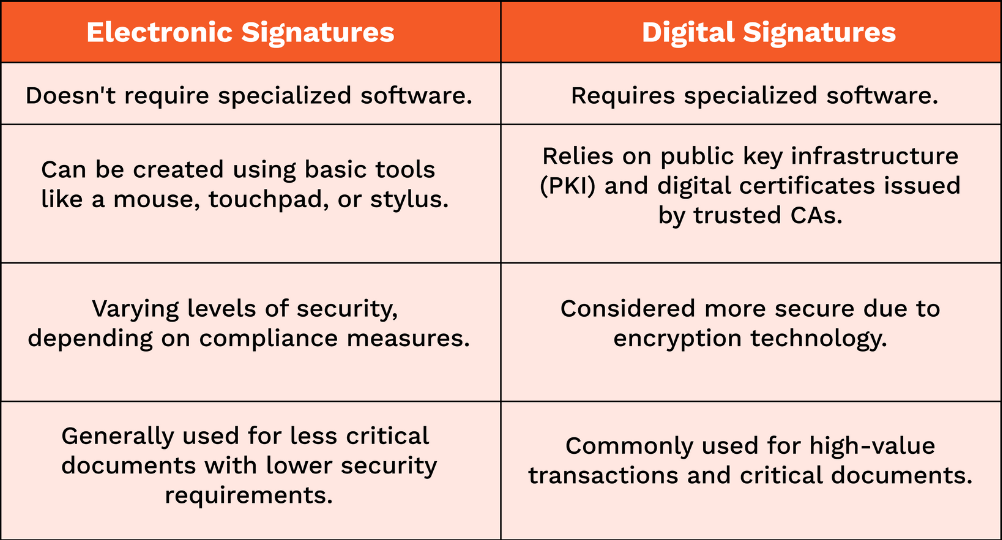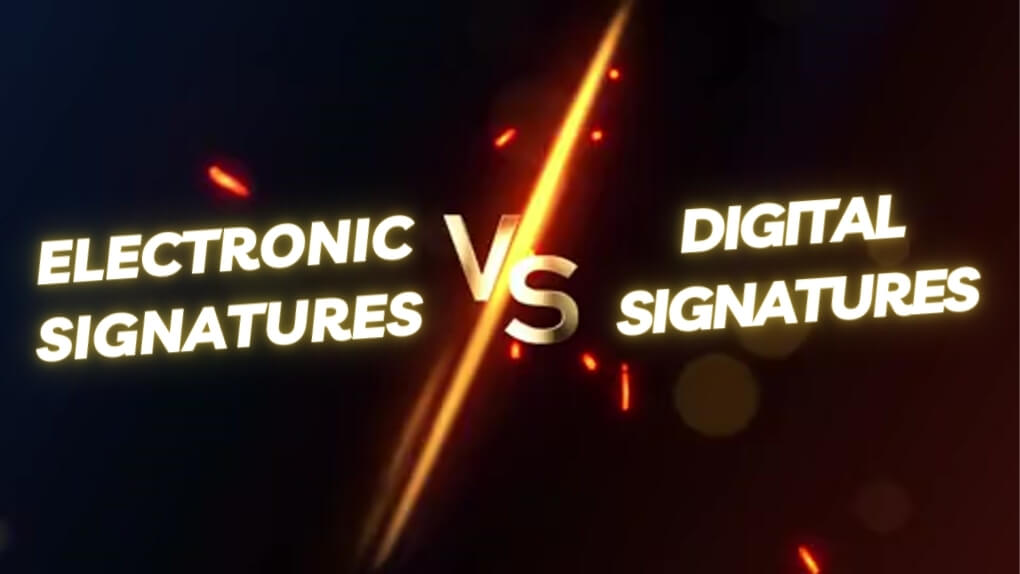As Kindle and iPad replace books, the traditional practice of signing physical contracts with a pen has been largely replaced by electronic signatures. However, despite their prevalence, there continues to be confusion between two distinct types of electronic signatures: electronic and digital. Although they both serve the common purpose of signifying an agreement on a document, their levels of security, legal implications, and areas of application vary considerably.
In this blog post, we will discuss electronic signatures and digital signatures, their benefits, use cases, legal implications, technical aspects, and associated compliance.
Understanding Electronic Signatures:
Let’s start with the most common one. An electronic signature (e-signature) is a digital equivalent of a handwritten signature. It can be a typed name, a scanned image of a signature, or even a recorded voice. E-signature software usually offers a range of options for applying these signatures, making them an easy and effective way to handle everyday agreements.
Benefits of Using E-Signatures
Imagine you have a big cake that you can share with your friends. The cake is your company, and the slices are the shares. You can decide how many portions you want to cut, and how many you want to give away but the size of the cake is fixed and is called authorised share capital. As the size of the cake is decided at the time you order it, similarly, the authorised share capital is determined when you incorporate the company. However, it can be changed as long as all the friends at the table agree.
This article will explore the advantages of maintaining adequate authorised capital and how it can positively impact your business in the long run.
Advantages of Optimum Authorised Share Capital
Increased Convenience:
The implementation of electronic signature technology is an efficient way to enhance your document signing process. It not only saves time but also reduces costs associated with printing and mailing physical documents. This technology is capable of providing the necessary security measures for the electronic signing process, including encryption, digital certificates, and audit trails, ensuring the authenticity and integrity of the signed documents.
Improved Workflow:
Choosing e-signatures can greatly enhance the efficiency of document workflows by enabling swift completion and approval processes. This allows you to concentrate on more pressing matters.
Enhanced Accessibility:
Additionally, e-signatures offer enhanced accessibility, allowing you to effortlessly sign documents from anywhere and at any time, making the process more efficient and accessible, regardless of your location.
Types of Electronic Signatures.
Electronic signatures come in two main types:
-
Simple Electronic Signatures (SES):
SES is the most basic type, and it often relies on email addresses or passwords for authentication, providing minimal security.
-
Advanced Electronic Signatures (AES):
On the other hand, AES utilizes cryptography and digital certificates to verify the signer's identity and document integrity, offering a much higher level of security.
Understanding Digital Signatures
Let's delve into a more intricate topic - digital signatures. These signatures go beyond simply replicating a handwritten signature. They leverage advanced cryptography and digital certificates issued by trusted third-party authorities, also known as Qualified Trust Service Providers, to generate a unique "digital fingerprint" of the signed document. This fingerprint ensures the authenticity and precision of the document, effectively hedging against any potential tampering or forgery.
Benefits of Digital Signatures
Stronger Security:
Cryptography and digital certificates provide robust authentication and integrity checks, making them ideal for highly sensitive documents and transactions.
Enhanced Legal Validity:
In most countries, digital signatures meet specific legal requirements and are considered legally binding, just like handwritten signatures.
Non-repudiation:
The signer's identity is cryptographically tied to the document, making it virtually impossible to deny signing it later.
Use Cases for Electronic vs. Digital Signatures
When choosing the right signature type, it's crucial to assess your specific needs thoroughly. Factors such as the document's sensitivity, legal obligations, and desired level of security should all be taken into account to make an informed decision.
It's important to note that while both electronic and digital signatures are acceptable means of signing electronic documents, digital signatures provide significantly higher levels of security and legal validity, making them the preferred option for critical transactions and important documents. As explained below:
- E-signatures: Suitable for everyday agreements with low risk, such as non-disclosure agreements, purchase orders, or internal documents.
- Digital signatures: Preferred for high-value transactions and sensitive documents, such as contracts, financial agreements, legal documents, and government forms.
Implementing these recommendations and prioritizing clarity, brevity, and relevant examples delivers an educational overview of electronic and digital signatures for a wider audience.
Key Differences Between Electronic and Digital Signatures

Widespread Adoption and Benefits
As our world evolves into a digital age, more and more businesses are turning to e-signatures and workflow automation to streamline their contract processes. These cutting-edge tools provide numerous advantages, such as boosting team efficiency, ensuring security through encryption and digital certificates, and creating audit trails.
By utilizing these features, a company can drastically reduce the resources needed to manage contracts, while also improving productivity and meeting regulatory standards. Moreover, e-signatures and workflow automation can save costs by eliminating the need for printing, mailing, and storing physical documents.

Source: IDC's North America eSignature Market Survey, November 2021
Legality of These Signatures
The era of relying solely on hand signatures is a thing of the past. In today's digital landscape, electronic signatures have gained widespread acceptance, and many nations now recognize them as legally binding evidence in court.
With advanced security measures and rigorous authentication methods, secure digital signatures are often viewed as equivalent to traditional signatures. Legal frameworks, such as the US ESIGN Act and the EU's eIDAS Regulation, provide guidance for their use. Nonetheless, it's essential to comprehend the specific laws and regulations within your jurisdiction to ensure compliance and legal validity.

Addressing the Security Concerns:
While generally secure, e-signatures can face risks like forgery and fraud. To combat this security concern, various authentication measures exist:
- Biometrics: Fingerprints, facial recognition, and voice recognition add an extra layer of security.
- Digital certificates: Issued by trusted third parties, verify signer identity and document integrity.
- Two-factor authentication: Requires additional verification, like a one-time code, for increased security.
Compliance and Technology Landscape:
Various regulations, such as ISO, SOC2, HIPAA, and GDPR, establish benchmarks for safeguarding data and preserving consumer privacy. In different locales, eIDAS, UETA, E-SIGN, and IT Act laws dictate the validity of electronic signatures.
Technology continues to be a crucial factor, with innovations such as blockchain for secure data storage and AI for detecting anomalies and preventing fraud. Quantum-resistant cryptography offers additional protection against potential threats, such as quantum computing.
Conclusion
To fully take advantage of the benefits of e-signatures, it is imperative to select a secure platform that meets your needs. This process will involve conducting thorough research and reading reviews to ensure your chosen platform is reliable and secure. With the right platform, you can confidently embrace the convenience and efficiency of e-signatures and streamline your business processes.



